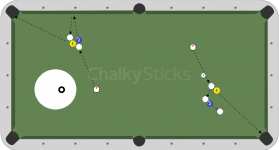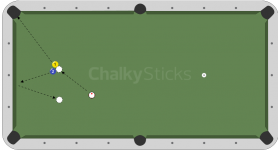I've gotten some decent feedback on my patterns thread, so I decided to make another on manufacturing breakballs. This as an advanced skill which usually develops slowly alongside your other specialized straightpool skills. There are, however, certain patterns which can significantly improve this skill.
1. I start this lesson with the most common and easy of those, Which I like to call the "L" pattern. You will see why in the blue circle in the picture. These ball configurations come up over and over again in the rack area and along the rails, and only your imagination limits how they can be used. This is the basic version of that pattern.
1. I start this lesson with the most common and easy of those, Which I like to call the "L" pattern. You will see why in the blue circle in the picture. These ball configurations come up over and over again in the rack area and along the rails, and only your imagination limits how they can be used. This is the basic version of that pattern.
Attachments
Last edited:




